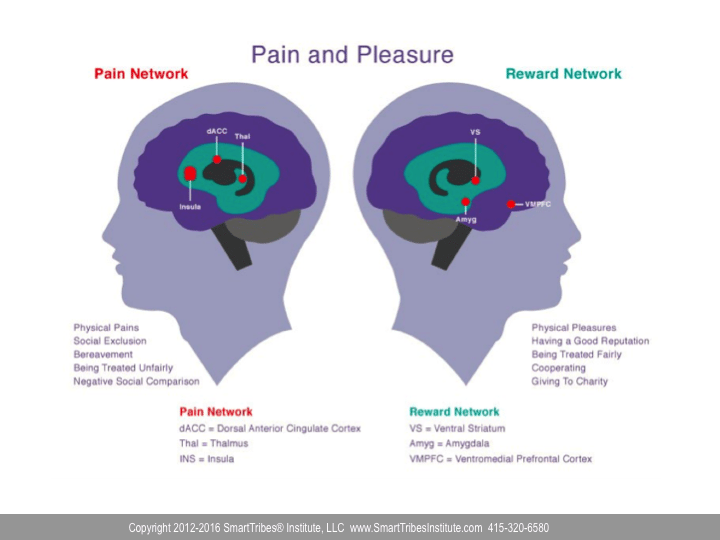
*As originally seen on Forbes.com
Distrust is rampant. It’s worldwide. It’s pervasive across all types of organizations in the business world. Even though the trust of CEOs is at an all-time low, we can help heal the distrust that may exist in your organization and boost your trust-factor among your tribe.
Are you ready?
You Can’t Buy Trust
Organizations can’t ‘buy’ the trust of their team, but they can create and foster it through increasing engagement and avoiding common pitfalls.
A tribe that continuously activates the reward network — smart tribe — is more productive and effective.

via UCLA
A tribe that continuously activates the pain network suffers from three common leadership pitfalls:
• Pitfall #1: Asking for feedback yet not acting on it
• Pitfall #2: Unemotional or not compelling mission, vision values
• Pitfall #3: Ineffective delegation
When we activate the reward network, an organization inspires intrinsic motivation in their tribe. This intrinsic motivation creates an environment where your talent wants to rise up, be accountable, honor the organization’s mission, vision, values and deliver consistent results.
Thanks to Seth Godin, here is a clearly laid out map to ensure you’re building trust most effectively. While this applies to marketing your brand, you are not only marketing your brand to your customers, but you are marketing your brand to your potential and existing talent within your tribe. Potential talent interacts with your brand far before the interview ever takes place. Once hired, talent will continue to interact with your brand ongoing.
Here are Seth’s nine factors/aspects of building a powerful brand that inspires trust:
• Word Of Mouth: If I’ve heard good things about you, I am more inclined to trust you.
• Direct Interaction: Have you already interacted with me?
• Tone Of Voice: Does the tone build the relationship and foster Safety, Belonging, Mattering?
• Offer: What’s in it for me to listen to what you have to say? Do I gain more if I listen with an engaged and sympathetic ear?
• Size Of Leap: What are you asking me to do? How big is it?
• Tribal Affiliation: Are you one of us? Am I one of you?
• Perception Of Transparency: When I can understand your intention, I’m more inclined to trust you.
• Longevity: How long have you been showing up? How do you consistently treat your tribe?
• Mass Acceptance: When I hear about you from other tribe members, what are they saying? Is what they are saying, positive or negative, based in truth (perceived or real)?

Shutterstock
Trust Drives Talent
Accountability is deeply tied to promises and trust. Safety, belonging, and mattering are quickly damaged when accountability is dropped. In previous blogs, I have discussed how as leaders, it’s key when administering consequences to determine if accountability is being dropped because the person is in their Critter State and is stuck, or if they are intentionally uncooperative.
In my experience, trust is broken in three levels: capability, commitment and character. The same applies to how trust is broken and egos are triggered from the perception of your tribe.
• Capability: Is the organization truly capable of doing what was promised? Capability breaches of trust are the easiest to fix if a company moves swiftly and is transparent.
• Commitment: Is the organization committed to following through on what was promised? Commitment breaches can be tricky. When an organization repeatedly drops commitments, we must find out what the underlying cause is. This can be achieved through leaders working with an executive coach and discovering/determining what they truly want to achieve using the Outcome Frame. This can also be achieved by listening to the feedback from the tribe.
• Character: If an organization keeps making promises and breaking them, who are they, really? An empowered and engaged tribe wants to be part of an organization they can count on. Character breaches are the hardest to fix since the tribe now doubts what the organization totally stands for.
Breaches in capability, commitment and character can take months or even years of demonstrating consistency to win back trust. The organizations that I’ve worked with typically see positive results begin within 6-18 months, depending on the level of Critter State among their team and the severity of the breach.
Trust Drives ROI
According to Paul J. Zak, founding director for the Center of Neuroeconomics Studies at Claremont Graduate University, “In its 2016 global CEO survey, PwC reported that 55% of CEOs think that a lack of trust is a threat to their organization’s growth. But most have done little to increase trust, mainly because they aren’t sure where to start.”
Compared with people at low-trust companies, people at high-trust companies report:
• 74% less stress
• 106% more energy at work
• 50% higher productivity
• 13% fewer sick days
• 76% more engagement
• 29% more satisfaction with their lives
• 40% less burnout
Two practices to increase trust:
1. Look at Seth’s nine criteria above and scale yourself 1-5 (5 being the highest)and this will show you where you need to work.
2. Consider your organization’s capability, commitment, and character. How are you doing?





